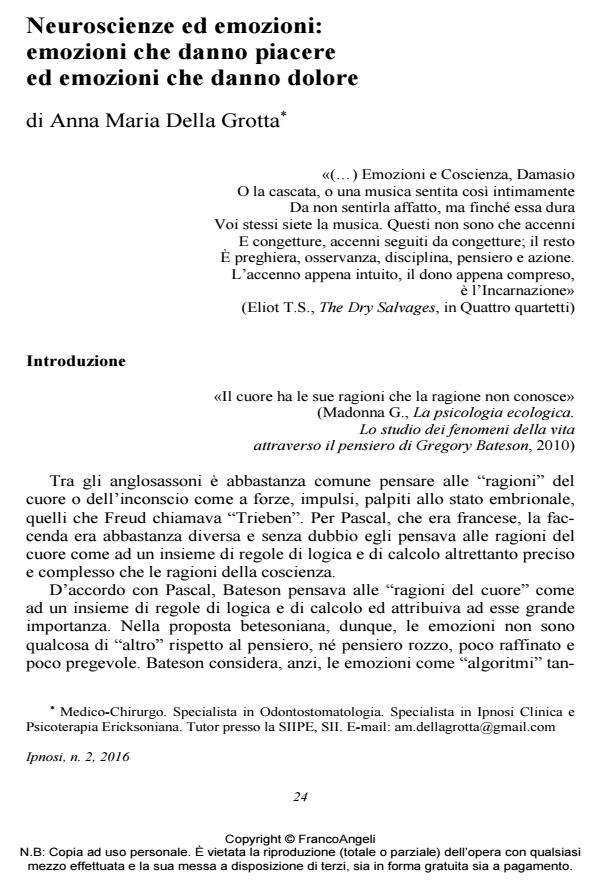Neuroscienze ed emozioni: emozioni che danno piacere ed emozioni che danno dolore
Journal title IPNOSI
Author/s Anna Maria Della Grotta
Publishing Year 2016 Issue 2016/2
Language Italian Pages 17 P. 24-40 File size 222 KB
DOI 10.3280/IPN2016-002002
DOI is like a bar code for intellectual property: to have more infomation
click here
Below, you can see the article first page
If you want to buy this article in PDF format, you can do it, following the instructions to buy download credits

FrancoAngeli is member of Publishers International Linking Association, Inc (PILA), a not-for-profit association which run the CrossRef service enabling links to and from online scholarly content.
Over the past years, neurosciences have developed a technology for the study of brain activity, which allowed facing problems usually considered to belong to the philosophical domain. This allowed an increase of knowledge concerning the functioning of the central nervous system during ordinary and special state of consciousness, among which the hypnosis. Knowledge is an instinctive and biological mechanism that colors our existence and helps us through the fundamental duties in life, as looking for pleasure and avoiding the pain. We build up mental models in order to forecast what the other person is about to do and to confirm our motivations to do things (Kandel, 2012). Empathy is a tool for the understanding of other persons past moods, either moods of joy or pain, and it is, even theoretically, an ability to share human experiences. Pain is an experience that cannot be easily defined, given the countless shades in terms of anthropology, socio-culture, history and religion of which such experience has been enhanced over the past eras and though populations. The natural under layer of the empathic experience of pain does not include its entire neuro-matrix, but only the segment of the neural network, the one associated to the affective properties of experience and not to the sensorial properties. The perceptual component of the pain (or neurological component) is composed of a neural circuit that guides the painful stimulus from the edge to the medial cerebral cortex (the spinothalamic tract). The discovery of hundreds of news genes connected to mental disturbs (such as schizophrenia, depression, anxiety, bipolar disorder and so on) evokes that the scale is now leading towards nature, instead of education. This fear is, erroneously, consolidated by popular opinion that psychotherapy might have something to offer to disorders with psychological basis, while medicine is the treatment to disturbs with biological basis. In order to understand the pain system, it is required to be aware of all the features and qualities of subjective sensations, and of its various correlations. Within the entire context of contemporary science, there are many aspects we do not understand, one of which is ourselves.
Keywords: Neuroscience, Emotions, Pain, Psychotherapy, Hypnosis.
Anna Maria Della Grotta, Neuroscienze ed emozioni: emozioni che danno piacere ed emozioni che danno dolore in "IPNOSI" 2/2016, pp 24-40, DOI: 10.3280/IPN2016-002002